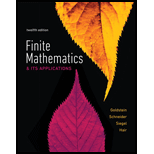
Concept explainers
Table 17 gives the probability distribution of the random variable U.
Table 17
k |
|
0 |
|
1 |
|
2 |
|
3 |
|
4 |
? |
(a) Determine the probability that
(b) Find
(c) Find the probability that U is at most 3.
(d) Find the probability that
(e) Draw the histogram of the distribution of U.
Want to see the full answer?
Check out a sample textbook solution
Chapter 7 Solutions
MyLab Math plus Pearson eText -- Standalone Access Card -- for Finite Mathematics & Its Applications (12th Edition)
Additional Math Textbook Solutions
Pathways To Math Literacy (looseleaf)
Elementary Statistics (13th Edition)
College Algebra Essentials (5th Edition)
Precalculus
Elementary Statistics ( 3rd International Edition ) Isbn:9781260092561
Finite Mathematics for Business, Economics, Life Sciences and Social Sciences
- Explain the conditions under which the Radius of Convergence of the Power Series is a "finite positive real number" r>0arrow_forwardNo chatgpt pls will upvotearrow_forwardQ/By using Hart man theorem study the Stability of the critical points and draw the phase portrait of the system:- X = -4x+2xy - 8 y° = 4y² X2arrow_forward
- This means that when the Radius of Convergence of the Power Series is a "finite positive real number" r>0, then every point x of the Power Series on (-r, r) will absolutely converge (x ∈ (-r, r)). Moreover, every point x on the Power Series (-∞, -r)U(r, +∞) will diverge (|x| >r). Please explain it.arrow_forwardExplain the conditions under which Radious of Convergence of Power Series is infinite. Explain what will happen?arrow_forwardExplain the conditions under Radius of Convergence which of Power Series is 0arrow_forward
- Explain the key points and reasons for 12.8.2 (1) and 12.8.2 (2)arrow_forwardQ1: A slider in a machine moves along a fixed straight rod. Its distance x cm along the rod is given below for various values of the time. Find the velocity and acceleration of the slider when t = 0.3 seconds. t(seconds) x(cm) 0 0.1 0.2 0.3 0.4 0.5 0.6 30.13 31.62 32.87 33.64 33.95 33.81 33.24 Q2: Using the Runge-Kutta method of fourth order, solve for y atr = 1.2, From dy_2xy +et = dx x²+xc* Take h=0.2. given x = 1, y = 0 Q3:Approximate the solution of the following equation using finite difference method. ly -(1-y= y = x), y(1) = 2 and y(3) = −1 On the interval (1≤x≤3).(taking h=0.5).arrow_forwardФ sketch stability x= -4x + 2xy - 8 y° = 4 y 2 - x² чуг.arrow_forward
- 2 Q/Given H (x,y) = x² + y² - y² Find the Hamiltonian System and prove it is first integral-arrow_forwardQ2) A: Find the region where ODEs has no limit cycle: x = y + x³ y=x+y+y³ 6arrow_forwardQ3)A: Given H(x,y)=x2-x+ y²as a first integral of an ODEs, find this ODES corresponding to H(x,y) and show the phase portrait by using Hartman theorem and by drawing graph of H(x,y)-e. Discuss the stability of critical points of the corresponding ODEs.arrow_forward
- Algebra & Trigonometry with Analytic GeometryAlgebraISBN:9781133382119Author:SwokowskiPublisher:Cengage
 College AlgebraAlgebraISBN:9781305115545Author:James Stewart, Lothar Redlin, Saleem WatsonPublisher:Cengage Learning
College AlgebraAlgebraISBN:9781305115545Author:James Stewart, Lothar Redlin, Saleem WatsonPublisher:Cengage Learning College Algebra (MindTap Course List)AlgebraISBN:9781305652231Author:R. David Gustafson, Jeff HughesPublisher:Cengage Learning
College Algebra (MindTap Course List)AlgebraISBN:9781305652231Author:R. David Gustafson, Jeff HughesPublisher:Cengage Learning


